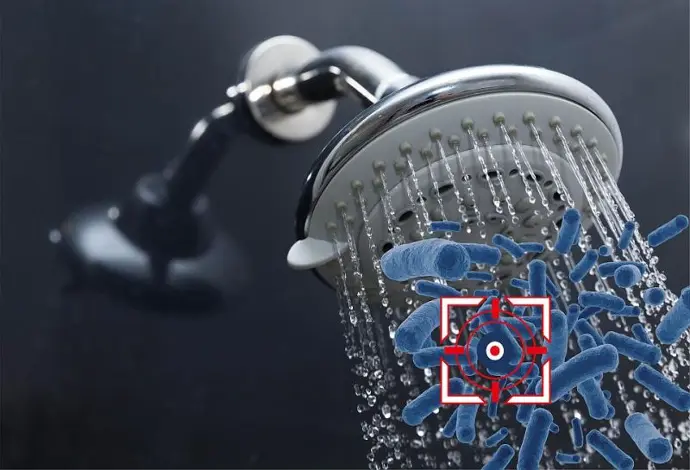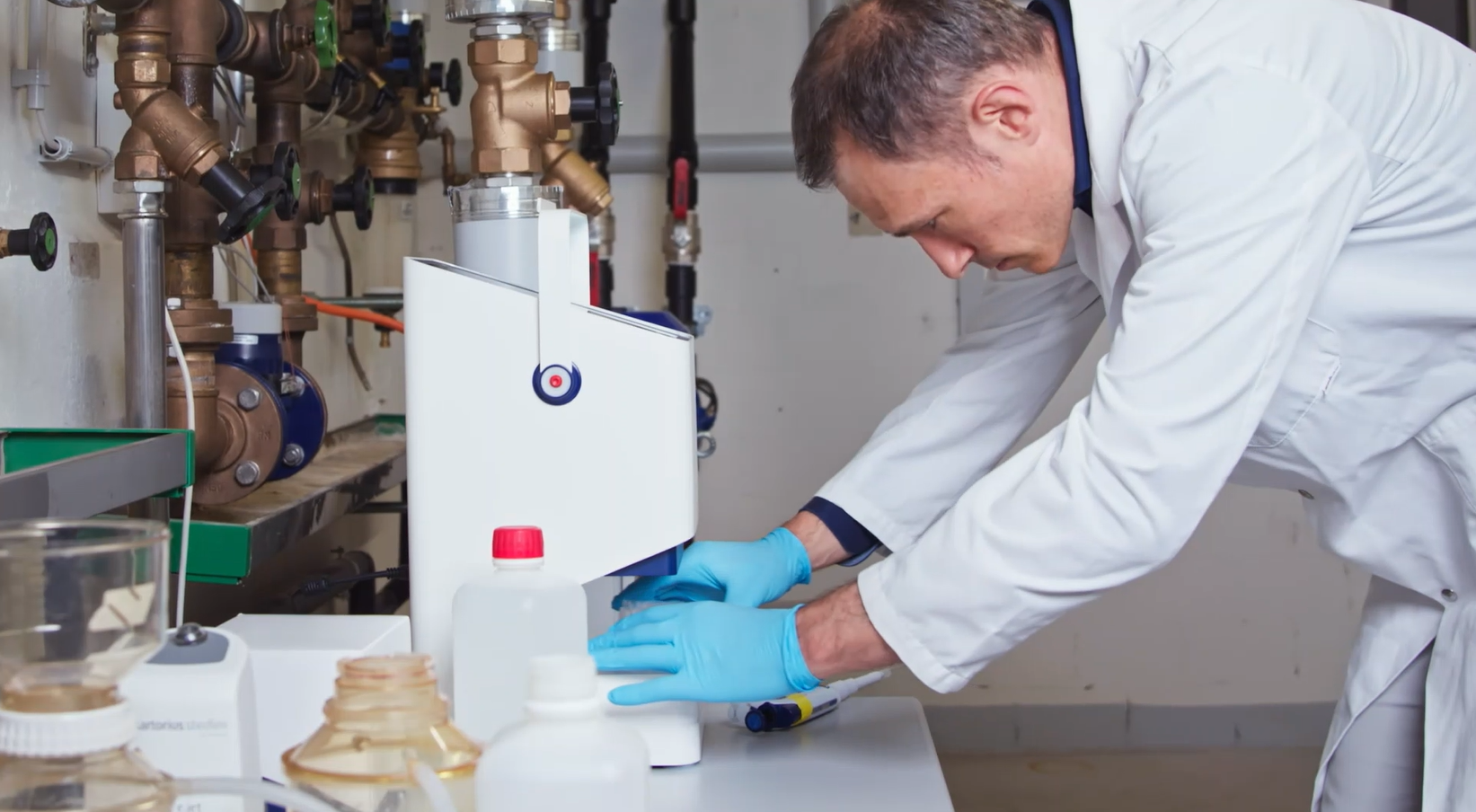Legionnaires’ Disease
Following an outbreak of severe pneumonia at an American Legion convention in 1976, the bacteria Legionella pneumophila was identified as the illness-causing agent [1]. The spread of the so-called Legionnaires’ disease was presumably airborne [2] [1]. The deadly outbreak at the American Legion convention initiated Legionella research around the world and impacted public health policy and guidelines of industry associations. Nevertheless, Legionella continue to be a threat to public health. The newest edition of the European Drinking Water Directive cites the WHO, noting that “in the Union, Legionella causes the highest health burden of all waterborne pathogens” (link).
Legionella are present in water and can be found in both natural and artificial water
systems [3] [4] where they preferably
grow between 20
°C and 45 °C [5]. The bacteria can
be aerosolized from various water sources in the built environment such as showers,
faucets, hot tubs, swimming pools, cooling towers and fountains [6]. Because Legionella
are transmitted via bacteria-containing aerosols [7] [8] [9], occurrence of Legionnaires’
disease is predominantly associated with artificial aquatic environments such
as cooling towers, whirlpools and spas [1].
Legionella in Public Showers in Switzerland
In a recently published article from SRF, 11% of the controlled public showers in the Swiss cantons Graubünden and Glarus exceeded limit values for Legionella. In two instances, the affected showers were even closed to mitigate public health risks. Facilities with non-acceptable levels of Legionella contamination had to demonstrate self-control measures.

Aerosols from showers are potentially exposing people to Legionella [9] while at least 90% of reported Legionnaires’ disease cases are caused by the most dangerous subtype Legionella pneumophila [8]. Inhalation of contaminated aerosols is responsible for the transmission of Legionella into human lungs where they can cause legionellosis. Both Legionnaires’ disease as serious case of pneumonia as well as Pontiac Fever, which is characterized by influenza-like symptoms, are types of legionellosis [1] [5] [6].
Air humidity and temperature as well as aerosol generation affect the airborne bacterial spread of Legionella [8]. Nevertheless, numerous questions remain in terms of water-to-air transmission of Legionella. For instance, what kind of water sources produce the largest concentration of airborne bacteria? How long can the bacteria persist in this aerosolized state? And what factors determine their viability? How many viable Legionella are sufficient to cause an infection in humans and thus lead to disease? Finding answers to these questions is critical because this knowledge might advance our understanding of the etiology of Legionnaires’ disease [6].
The cultivation method, a standard method of analysis used in many microbiology tests [4] [8], is proven to miss a substantial share of Legionella present in a sample, particularly after water treatment [8]. Therefore, culturing often fails to identify the source of an outbreak and is unsuitable for an effective risk management in water systems [10] [11].
Play It Safe With the rqmicro.COUNT
Since showers produce aerosols, they might serve as reservoirs of clinically relevant Legionella [5]. However, only a fraction as low as 0.1 – 1% of bacteria present in water samples are culturable, and stressors like heat or chlorination might inhibit growth of viable Legionella [8]. Thus, cultivation-dependent methods are at risk of providing misleading results and false conclusions, for instance regarding the effectiveness of a given treatment [8].
With rqmicro.COUNT, you can reliably and accurately quantify Legionella pneumophila in your water samples in less than two hours. This flow-cytometry based technology from rqmicro captures also the non-growing fraction of Legionella cells which aids in evaluating water treatment effects.

This is especially relevant for facility managers and for building owners in order to mitigate risks for public health. Be it with your own, portable instrument or by using our lab service offer for Switzerland, rqmicro.COUNT will mark an important step in your Legionella risk management since the technology improves the understanding of your water system and enables you to keep public facilities safe.
Get in touch with our sales representative for a free consultation on our solution.
References:
[1] Diederen, B. M. W. "Legionella spp. and Legionnaires' disease." Journal of infection 56.1 (2008): 1-12.
[2] Fraser, David W., et al. "Legionnaires' disease: description of an epidemic of pneumonia." New England Journal of Medicine 297.22 (1977): 1189-1197.
[3] Cunha, Burke A., Almudena Burillo, and Emilio Bouza. "Legionnaires' disease." The Lancet 387.10016 (2016): 376-385.
[4] Fields, Barry S., Robert F. Benson, and Richard E. Besser. "Legionella and Legionnaires' disease: 25 years of investigation." Clinical microbiology reviews 15.3 (2002): 506-526.
[5] Collins, Samuel, et al. "Occurrence of Legionella in UK household showers." International journal of hygiene and environmental health 220.2 (2017): 401-406.
[6] Prussin II, Aaron J., David Otto Schwake, and Linsey C. Marr. "Ten questions concerning the aerosolization and transmission of Legionella in the built environment." Building and environment 123 (2017): 684-695.
[7] Huang, Shih-Wei, et al. "Water quality parameters associated with prevalence of Legionella in hot spring facility water bodies." Water research 44.16 (2010): 4805-4811.
[8] Wiik, Ragnhild, and Anne Vatland Krøvel. "Necessity and effect of combating Legionella pneumophila in municipal shower systems." PLoS One 9.12 (2014): e114331.
[9] Schoen, Mary E., and Nicholas J. Ashbolt. "An in-premise model for Legionella exposure during showering events." Water research 45.18 (2011): 5826-5836.
[10] Li, Laam, et al. "The importance of the viable but non-culturable state in human bacterial pathogens." Frontiers in microbiology 5 (2014): 258.
[11]
Parthuisot, N., et al. "Total and viable Legionella pneumophila cells in
hot and natural waters as measured by immunofluorescence-based assays and
solid-phase cytometry." Applied and environmental microbiology 77.17
(2011): 6225-6232.